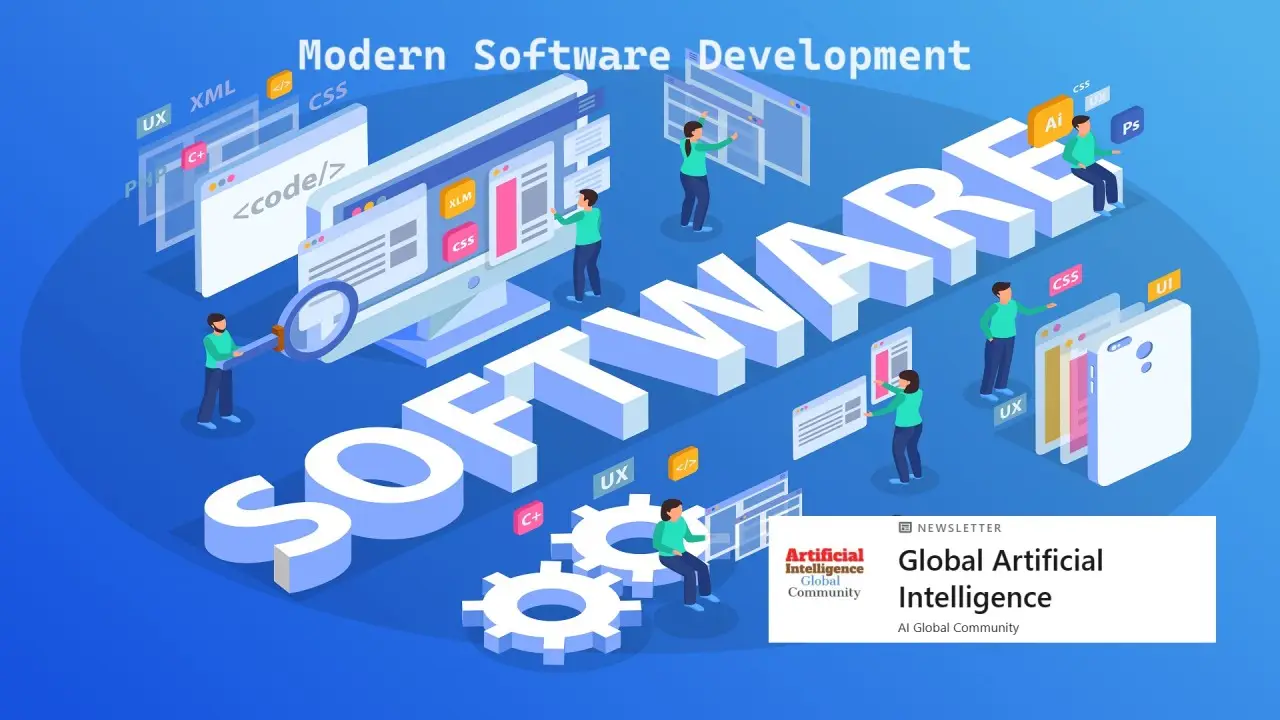Explore why ‘Modern Software Development Mostly Overhead’ rings true today. From bloated processes to productivity drains, discover how developers are navigating complexity in pursuit of real progress.
In today’s tech world, the speed of innovation is crucial. Yet, many software teams find themselves tangled in complexities. Meetings, documentation, and endless processes can overwhelm even the most skilled developers. This overhead can lead to frustration and wasted time.
It diverts focus from the core task: building amazing software. Understanding this issue is vital. It helps identify inefficiencies and streamline work. By addressing overhead, teams can boost productivity. They can also improve software quality and user satisfaction. In this blog, we’ll explore how overhead affects development. We’ll also discuss strategies to minimize it and enhance creativity. Let’s dive into the world of modern software development.

Credit: www.fullstackacademy.com
Introduction To Software Development Costs
Software development costs have risen dramatically over the years. Understanding these costs is crucial for businesses and developers alike. Knowing where these costs come from can help manage budgets effectively. Let’s explore how software development costs have evolved.
Historical Perspective
In the early days, software development was simpler. Developers worked on small projects with limited resources. Costs were mainly tied to hardware and basic software tools. As technology advanced, projects grew larger and more complex. New programming languages and tools emerged, increasing costs. Teams expanded, requiring more coordination and management. This added layers of expenses previously unseen.
Current Trends
Today, software development involves many moving parts. Cloud services play a significant role in modern costs. Subscription-based tools and platforms add to monthly expenses. Security has become a major concern, demanding specialized solutions. Agile methodologies are popular, but they require constant iteration. This leads to ongoing expenses throughout development cycles. Outsourcing is common, affecting budget planning and allocations. Businesses must adapt to these trends to remain competitive.

Credit: www.dnv.com
Hidden Expenses In Development
Modern software development often carries hidden costs. These include management overhead, communication barriers, and unexpected technical challenges. Understanding these expenses can help optimize budgets and improve project outcomes.
Modern software development can appear straightforward at first glance. However, hidden expenses can quickly escalate, impacting your project’s budget and timeline. Understanding these hidden costs is crucial to maintaining a smooth development process and ensuring financial efficiency.
###
Infrastructure Costs
Setting up the right infrastructure can be daunting. Cloud services, servers, and storage solutions aren’t free, and their costs can add up quickly. You might think you’re saving money by choosing a cheaper option, but unforeseen performance issues could lead to costly downtimes.
Imagine setting up a project only to realize halfway through that your server isn’t robust enough. The cost of upgrading mid-project can be significantly higher than starting with the right setup from the beginning. Consider conducting a thorough needs assessment to determine what infrastructure will best support your project, both now and as it grows.
###
Licensing Fees
Software licenses are another expense that can catch you off guard. Even the most efficient teams need tools, and many of these come with recurring fees. If you’re not careful, these fees can become a substantial part of your budget.
Picture this: you’ve developed an amazing application, but the cost of renewing licenses for necessary tools eats into your profits. Evaluating the long-term costs of licenses early in the planning phase can prevent unpleasant surprises. Are there open-source tools that can do the job just as well?
Hidden expenses in software development are like unexpected guests at a party. They can disrupt your plans if you’re not prepared. By being proactive and asking the right questions, you can mitigate these costs and keep your project on track. What steps will you take to ensure your next project stays within budget?
Human Resources And Talent
Modern software development often grapples with challenges in managing human resources and talent. You may wonder how the industry attracts, retains, and nurtures its workforce amidst rapid technological changes. Let’s dive into the essential aspects of salaries and benefits, as well as training and skill development, to see how they impact the workforce.
Salaries And Benefits
Competitive salaries are crucial in attracting top talent. Software developers often have a choice between several job offers. Companies must offer not just competitive pay but also appealing benefits.
Consider the benefits package. Health insurance, retirement plans, and flexible work options are increasingly important. They can make a difference in your decision to choose one company over another.
What about perks? Tech companies often offer unique benefits like gym memberships or free snacks. These can enhance job satisfaction and improve work-life balance.
Training And Skill Development
Technology evolves quickly. Keeping skills current is essential for career growth. You need access to regular training opportunities to stay ahead.
Look for companies that prioritize skill development. They might offer workshops, online courses, or mentorship programs. These resources can help you grow professionally and personally.
Have you ever thought about the future skills you’ll need? Continuous learning is key. Companies that invest in your development can be a valuable partner in your career journey.
In the end, how do you see your career evolving with the right support? Modern software development offers opportunities but requires strategic management of human resources and talent. Engage with companies that value your growth, and you’ll find your path to success.

Credit: softjourn.com
Tools And Technologies
Modern software development is a complex domain. It relies heavily on various tools and technologies. These elements help streamline processes and enhance productivity. They are crucial for crafting efficient and scalable solutions. Understanding these tools and technologies is essential for developers and businesses alike.
Software Tools
Software tools form the backbone of development tasks. They automate repetitive actions and simplify complex procedures. Popular tools include version control systems like Git. These tools help track changes and collaborate efficiently. Integrated Development Environments (IDEs) also play a significant role. They offer features like syntax highlighting and debugging. These features improve coding accuracy and reduce errors.
Hardware Requirements
Hardware requirements are equally vital in software development. Powerful computers enhance productivity by handling complex computations. Developers need machines with robust processors and ample RAM. These specifications ensure smooth running of development environments. High-resolution monitors are beneficial too. They aid in viewing code and design elements clearly. Reliable hardware supports uninterrupted workflow and faster project completion.
Project Management Overheads
Modern software development often brings significant overheads to project management. These include managing complex tools and coordinating diverse teams. Ensuring smooth communication and efficient workflows demands extra effort and resources.
Modern software development is a complex dance of creativity and coordination. While the technological side is thrilling, project management overheads often weigh heavily on teams. These overheads can slow down progress and lead to frustration. But understanding and addressing them can streamline your process and boost productivity.
Agile And Scrum
Agile and Scrum are popular methodologies in software development. They promise flexibility and rapid delivery. However, the very frameworks meant to enhance productivity can sometimes become burdensome.
In a Scrum meeting, have you ever felt like you’re spending more time updating tasks than actually doing them? This is a common scenario where the overhead of sticking to the process overshadows the benefits. Consider simplifying your sprints or adjusting the frequency of meetings. This can save time and keep the focus on actual development work.
Communication Tools
Communication tools are essential in modern software development. They help teams collaborate across the globe. But the irony is, these tools can also create a communication overload.
Have you ever been bombarded with notifications and found it hard to focus? Tools like Slack or Microsoft Teams are meant to help, but they can become distractions. Prioritize your communication channels. Decide which ones are necessary and which are just noise. Encourage your team to set boundaries on their availability to reduce interruptions.
The key is balance. How can you ensure that the tools meant to aid you don’t become a hindrance? Consider scheduling “quiet hours” where team members can focus without disturbance. By managing these tools effectively, you can minimize overhead and enhance productivity.
Project management overheads are a reality in software development. But with thoughtful adjustments, you can reduce their impact. Are you ready to tackle these challenges and make your development process more efficient?
Security And Compliance
Modern software development often faces challenges with security and compliance. These aspects can become significant overhead. Ensuring systems are safe and meet regulations is crucial. It requires ongoing attention and resources.
In today’s fast-paced tech world, security and compliance are no longer just buzzwords—they’re necessities. As you navigate modern software development, safeguarding your data and meeting regulatory standards are paramount. But what does this mean for your business? Let’s break it down.
Data Protection Costs
Protecting your data isn’t cheap, but it’s essential. Consider the costs of data breaches, which can cripple even the most robust companies. Investing in security measures upfront can save you money in the long run.
You might think of data protection as a significant expense. However, think of the potential legal fees and loss of customer trust if your data is compromised. Would you rather pay for prevention or deal with costly aftermaths?
Tools like encryption software and secure servers are part of the equation. But it’s also about training your team to recognize threats. Have you considered the cost of regular security training for your staff?
Regulatory Compliance
Navigating the maze of regulations can feel daunting. Yet, staying compliant is crucial to avoid hefty fines and maintain your reputation. Are you familiar with GDPR, HIPAA, or CCPA?
Each regulation has its own set of rules. Understanding them can be time-consuming, but it’s non-negotiable. Non-compliance can lead to financial penalties and damage to your brand.
You may need to hire experts or invest in software to ensure compliance. This might seem like a burden, but it’s a necessary step to protect your business. How much is your peace of mind worth?
Security and compliance in software development are not just about meeting minimum requirements. They are about safeguarding your business’s future and maintaining trust with your customers. Are you ready to make the necessary investments?
Maintenance And Support
Modern software development involves ongoing maintenance and support. This ensures the software remains functional and effective. Regular updates fix issues and enhance performance. Support teams address user concerns and provide solutions. Both aspects are crucial for software longevity.
Bug Fixing
Bug fixing is a key part of software maintenance. Developers identify and resolve software errors. This process ensures the software runs smoothly. Prompt bug fixes improve user satisfaction. Regular checks prevent major issues from arising.
Customer Support
Customer support plays a vital role in software success. Support teams assist users with software issues. They provide guidance and answer questions. Effective support builds trust with users. It enhances the overall user experience.
Optimizing Development Costs
Modern software development often faces high overhead costs. Streamlining processes and using efficient tools can help reduce expenses. Teams should focus on collaboration and automation to optimize development costs effectively.
In the fast-paced world of software development, managing costs without sacrificing quality is crucial. High expenses can sneak up on you, especially when dealing with advanced technologies and ever-changing requirements. Optimizing development costs involves balancing resources, technology, and manpower to maintain efficiency. How can you achieve this without compromising on innovation and performance?
Cost-effective Practices
Adopting cost-effective practices can significantly reduce overhead. Prioritize open-source tools and platforms to save on licensing fees. These tools often provide robust functionalities and a vibrant community for support.
Implement agile methodologies. They enable you to adapt quickly to changes, reducing wasted time on unnecessary features. Regular feedback loops ensure that the project stays aligned with user needs, minimizing costly revisions later.
Encourage a culture of continuous learning among your team. Investing in training can seem expensive upfront but will save money in the long run. Skilled developers write better code faster, reducing debugging time and project delays.
Future Of Software Development
The future promises even more opportunities to optimize costs. Automation is becoming a game-changer. Automated testing and deployment reduce human error and speed up the development process.
Consider cloud services for scalable infrastructure. Pay only for what you use, which is more economical than maintaining in-house servers. This flexibility allows you to respond swiftly to market demands without hefty upfront investments.
Remote work is another trend reshaping cost structures. It enables hiring talent from regions with lower living costs, reducing salary expenses. How are you preparing your development team for these upcoming shifts?
By focusing on these strategies, you can streamline your software development process. Embrace the changes and continue to explore innovative ways to keep your costs in check while delivering high-quality products.
Frequently Asked Questions
What Is Overhead In Software Development?
Overhead in software development refers to extra resources, time, or costs needed beyond direct programming tasks. It includes activities like project management, code reviews, and documentation. Reducing overhead can boost efficiency and cut expenses. Prioritizing essential tasks helps streamline processes and improve productivity.
What Is The Most Expensive Part Of Software Development?
The most expensive part of software development is typically the design and development phase. This stage requires skilled developers and extensive time investment. High-quality coding, user interface design, and functionality testing all contribute to higher costs. Proper planning and efficient processes can help manage these expenses effectively.
What Is Overhead Cost In Software Development?
Overhead cost in software development includes expenses not directly tied to coding. This covers utilities, office rent, equipment, and administrative salaries. These costs are necessary for maintaining operations but don’t contribute directly to software production. Managing overhead effectively is crucial for budget optimization and project profitability.
Who Is Software Development Mostly Done By?
Software development is primarily done by skilled developers and engineers. They design, code, and test software applications. Teams often include project managers and quality assurance specialists. Collaboration ensures efficient and high-quality software products. Companies and freelancers both contribute to software development.
Conclusion
Modern software development often involves complexity. Many processes create extra tasks. Teams must focus on reducing unnecessary steps. Efficiency boosts productivity and saves resources. Simple strategies can help. Streamlining methods can lead to better results. Prioritizing essential tasks keeps progress on track.
Developers should aim for clarity and straightforward solutions. Innovation thrives when overhead is minimized. Embrace simplicity and focus on core objectives. Balance is key in software projects. Remember, less is sometimes more. Keep things manageable and focused. This approach benefits everyone involved in development.






